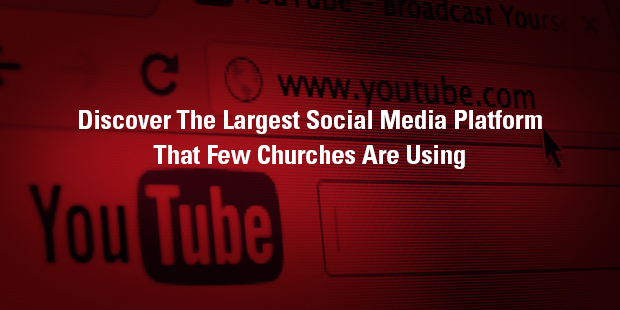
Discover the Largest Social Media Platform that Few Churches Are Using
In my latest book, Meet Generation Z, I detail the importance of the visual for Generation Z. In a new survey, Adweek confirmed the pre-existing research and conclusions.
Teaming up with Defy Media, they asked a group of nearly 1,500 teens ages 13-20 what they think about everything from social media platforms to digital video to the new breed of online celebrity.
The overarching headline that reflects the deeply online nature of their lives and their almost entirely visual orientation is that nearly all of them use YouTube (95%), and half “can’t live without it.” Not surprisingly, Instagram came in second in terms of usage (69%). Snapchat has now climbed to equal Facebook usage (67%), but when it comes to keeping in touch with their friends, Snapchat rules.
All of you Millennials still using Pinterest will find only 33% of Generation Z even know what you are talking about. Even Google is used only by 37% of their peers.
The combination of growing up online and their orientation to the visual has led them to value online, “social” celebrities more than mainstream celebrities. They trust their advice/endorsement more when it comes to everything from beauty products to tech gadgets.
But make no mistake: it’s all about the visual, and they are getting that visual primarily (for now) through YouTube.
It’s the primary way they get their news, tied with Facebook (23%).
It’s the number one place, by far, to get a good laugh (51%).
It’s the top go-to for shopping recommendations (24%), followed by Instagram (17%).
So what does this mean for the church?
Let’s go for low hanging fruit here: start using YouTube!
Here’s five simple ways to begin using YouTube to reach a YouTube generation:
1. Start a YouTube Channel.
It’s increasingly common for churches of all sizes to self-produce videos that are used in weekend services, student ministry and children’s ministry. Why not start your own YouTube channel for those videos? At Meck, we are developing multiple channels, and probably putting the most energy into the one for MecKidz, our ministry to children birth-fifth grade. This not only reinforces what they learned/saw on the weekend, but is in an easy way to share it with friends.
2. Use YouTube Videos.
If the most popular form of communication and discourse is visual in nature and housed on YouTube then, for goodness sake, use what people are talking about! Viral videos can be used as sermon illustrations, talking points, even for the basis of showing a point of view you wish to disagree with. If I can “show” something instead of “tell” it, I go for “show” every time. Sometimes they can just be a fun way to get into a topic that everyone can identify with or enjoy. For example, I did a 4-week series titled “Viral Verses” on the four most popular verses popping up on Bible apps and social media. Each week, I began by showing the most viral comedic video trending that week.
3. Develop YouTube-Style Videos.
When you develop videos – and as mentioned, many churches of all sizes find this feasible – consider the kinds of videos that are popular on YouTube. Most are not polished, but they do have identifiable styles and cuts, angles and vibes. Our children’s ministry team continually studies the most popular YouTube channels oriented toward children to stay abreast of style, and then develops our videos in similar fashion as a cultural bridge. For adults, think of the enormous popularity of DIY (do-it-yourself) videos, or TED talks. Take cues from what’s clearly popular when you develop your own.
4. Study YouTube Videos Culturally.
If we are an increasingly visual culture, and YouTube is the primary medium housing those visuals, then start studying YouTube culturally. Consider it “Missiology 101.” If you were to be dropped deep into the Amazon basin to reach an unreached people’s group, you would intuitively study their language, dress, music and more. The reality is that you are a missionary. And in most Western countries of the world, that is going to mean studying YouTube. When you do, here is what I would suggest you look for: 1) topics that seem to be of interest; 2) how people communicate, both stylistically and actual verbiage; 3) what are the most popular/viewed videos, and what seem to be their themes; and 4) obvious ways of thinking being manifest that you can either take advantage of or must learn new apologetics to counter.
5. YouTube Your Website.
Generation Z won’t read an ad, but they will watch one. They may not read a book, but they’ll see the film. So when it comes to your website, they may not read much of your written copy, but they’ll watch a short video. So rethink your website and move away from extensive writing to numerous short videos that present information about the page they are visiting. Emphasis on short. If you visit Meck’s website (mecklenburg.org), you’ll find very few pages that do not have an embedded video.
This is, of course, a very narrow set of suggestions related to one visual repository. The idea of becoming more visual in light of a culture that is increasingly visual can take on any number of forms – how you present music, how you illustrate a message, how you convey a story, how you capture attention, and how you move someone emotionally.
But let’s state the obvious:
… start with YouTube.
> Read more from James Emery White here.
Connect with an Auxano Navigator to learn more about your communication strategy.

Tags: Generation Z, James Emery White, YouTube, communication strategy, reaching Generation Z














